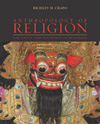
Religion as Expressive Culture |  |
Chapter Summary- Religion is a realm of emotionally powerful symbolism. Religious ideology has three important components: cosmology, myths, and legends.
- Religious world view, or cosmology, consists of beliefs about the nature of the supernatural and its relationship to human beings. It provides answers to questions about the nature of life and death, the reasons for the creation of the universe, and how human society originated.
- Myths are a religion's sacred stories about supernatural beings and powers, their roles in creating the universe and living things. They include stories about the origins of the first humans, the institution of human society, and the roles of early heroes who interacted with the gods.
- Meaning can be found at different levels in myths. On the surface, meaning has the form of a story line. Within the story there are powerful, individual mythic symbols. Finally, the structure of the myth may also convey meanings.
- Legends are stories about the early times in human existence that follow the times of mythology and whose characters, though heroic, are more like modern humans.
- Religious ideology is less immediately constrained by the practicalities of daily life than are other parts of ideology. Yet, it variability is not without some limits. The beliefs and values of any religion must somehow speak to those who follow it must remain within the realm of what seems plausible to those followers despite its contradiction of their "common sense" understandings about the world around them.
- Many specific religious beliefs are conditioned by particular characteristics of the social organization of the society in which they are found. For instance, belief in monotheism, polytheism, ancestral spirits, reincarnation, the individual human soul, sorcery and witchcraft, and supernatural punishments for the violation of moral rules are each more likely to be found in societies whose social organizations have particular characteristics.
- Religious taboos function to maintain the apparent orderliness of religious ideologies and world views by forbidding acts that might make their inconsistencies more readily noticed.
- Religious technology may function to communicate information about religious statuses such as identifying one's religious affiliation or the positions of religious responsibility one may hold. Religious technology may also play an important role in the rituals and ceremonies of religion.
|
|
|